Oldsmobile Silhouette 2002 s Workshop Manual
Manufacturer: OLDSMOBILE, Model Year: 2002, Model line: Silhouette, Model: Oldsmobile Silhouette 2002Pages: 455, PDF Size: 2.97 MB
Page 51 of 455

1-45
Safety Belt Pretensioners
Your vehicle has safety belt pretensioners. You'll find
them on the buckle end of the safety belts for the
driver and right front passenger. They help the
safety belts reduce a person's forward movement in a
moderate to severe crash in which the front of the
vehicle hits something.
Pretensioners work only once. If they activate in a crash,
you'll need to get new ones, and probably other new
parts for your safety belt system. See ªReplacing
Restraint System Parts After a Crashº in the Index.
Rear Seat Passengers
It's very important for rear seat passengers to buckle up!
Accident statistics show that unbelted people in the rear
seat are hurt more often in crashes than those who are
wearing safety belts.
Rear passengers who aren't safety belted can be thrown
out of the vehicle in a crash. And they can strike others
in the vehicle who are wearing safety belts.
Rear Seat Outside Passenger Positions
Page 52 of 455
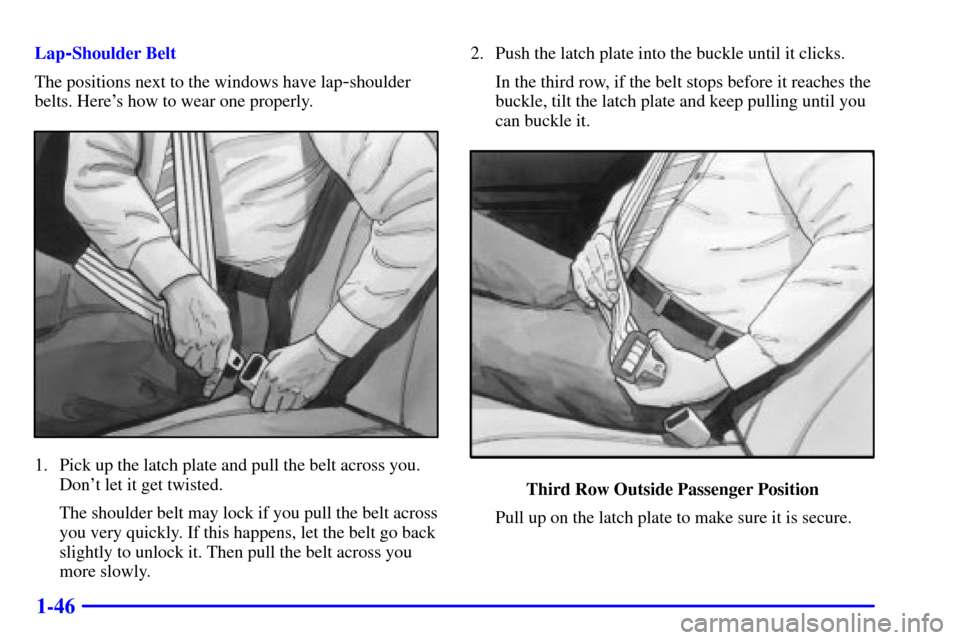
1-46
Lap-Shoulder Belt
The positions next to the windows have lap
-shoulder
belts. Here's how to wear one properly.
1. Pick up the latch plate and pull the belt across you.
Don't let it get twisted.
The shoulder belt may lock if you pull the belt across
you very quickly. If this happens, let the belt go back
slightly to unlock it. Then pull the belt across you
more slowly.2. Push the latch plate into the buckle until it clicks.
In the third row, if the belt stops before it reaches the
buckle, tilt the latch plate and keep pulling until you
can buckle it.
Third Row Outside Passenger Position
Pull up on the latch plate to make sure it is secure.
Page 53 of 455

1-47
When the shoulder belt is pulled out all the way, it
will lock. If it does, let it go back all the way and
start again. If the belt is not long enough, see ªSafety
Belt Extenderº at the end of this section. Make sure
the release button on the buckle is positioned so you
would be able to unbuckle the safety belt quickly if
you ever had to.
3. To make the lap part tight, pull down on the buckle
end of the belt as you pull up on the shoulder part.
The lap part of the belt should be worn low and snug on
the hips, just touching the thighs. In a crash, this applies
force to the strong pelvic bones. And you'd be less likely
to slide under the lap belt. If you slid under it, the belt
would apply force at your abdomen. This could cause
serious or even fatal injuries. The shoulder belt should go
over the shoulder and across the chest. These parts of the
body are best able to take belt restraining forces.
The safety belt locks if there's a sudden stop or a crash,
or if you pull the belt very quickly out of the retractor.
Page 54 of 455
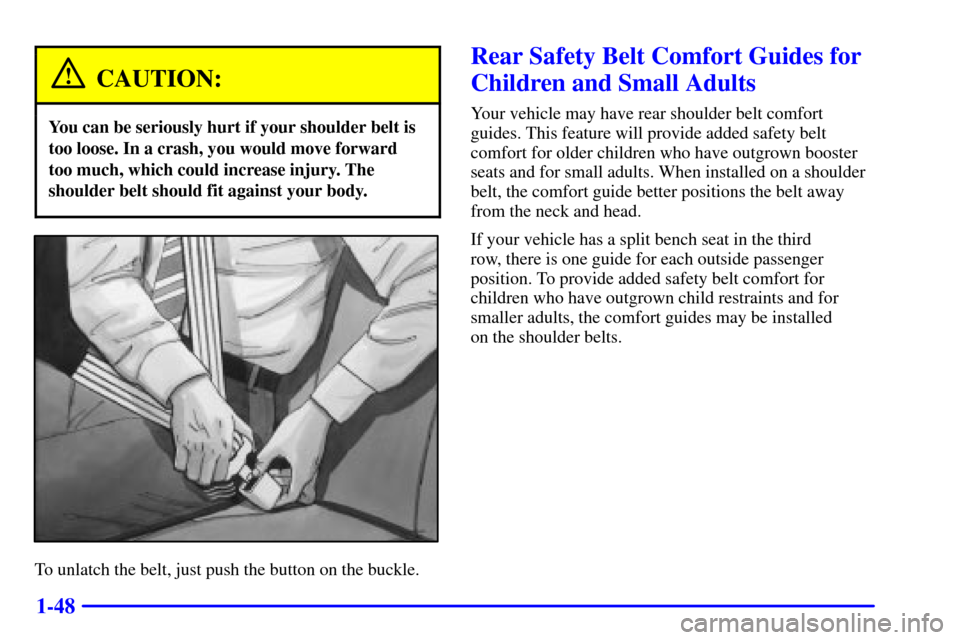
1-48
CAUTION:
You can be seriously hurt if your shoulder belt is
too loose. In a crash, you would move forward
too much, which could increase injury. The
shoulder belt should fit against your body.
To unlatch the belt, just push the button on the buckle.
Rear Safety Belt Comfort Guides for
Children and Small Adults
Your vehicle may have rear shoulder belt comfort
guides. This feature will provide added safety belt
comfort for older children who have outgrown booster
seats and for small adults. When installed on a shoulder
belt, the comfort guide better positions the belt away
from the neck and head.
If your vehicle has a split bench seat in the third
row, there is one guide for each outside passenger
position. To provide added safety belt comfort for
children who have outgrown child restraints and for
smaller adults, the comfort guides may be installed
on the shoulder belts.
Page 55 of 455
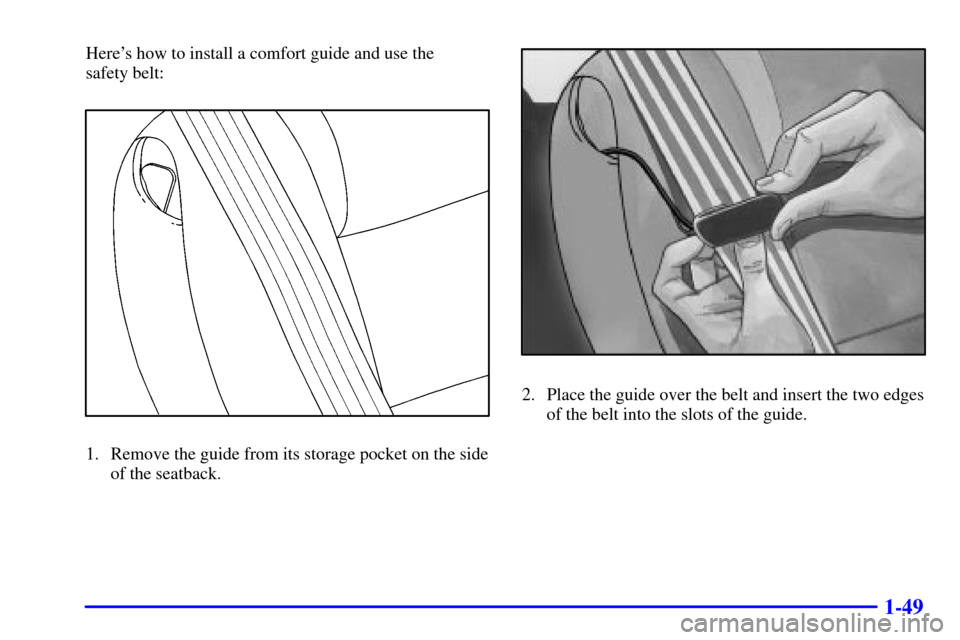
1-49
Here's how to install a comfort guide and use the
safety belt:
1. Remove the guide from its storage pocket on the side
of the seatback.
2. Place the guide over the belt and insert the two edges
of the belt into the slots of the guide.
Page 56 of 455
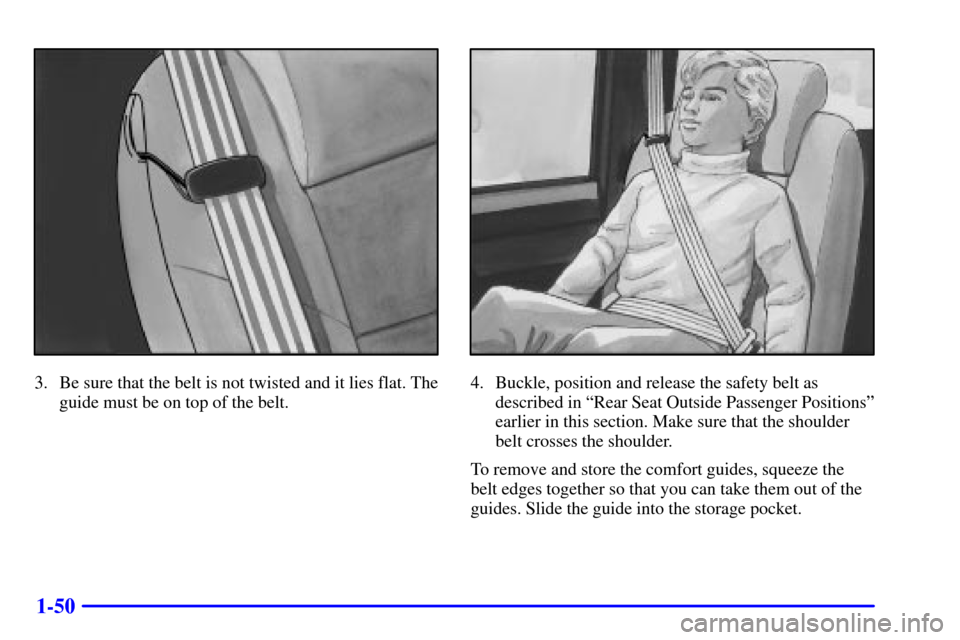
1-50
3. Be sure that the belt is not twisted and it lies flat. The
guide must be on top of the belt.4. Buckle, position and release the safety belt as
described in ªRear Seat Outside Passenger Positionsº
earlier in this section. Make sure that the shoulder
belt crosses the shoulder.
To remove and store the comfort guides, squeeze the
belt edges together so that you can take them out of the
guides. Slide the guide into the storage pocket.
Page 57 of 455

1-51
Center Passenger Position
(Bench Seat)Lap Belt
If your vehicle has a third row rear bench seat, someone
can sit in the center position.
When you sit in the center position of the bench seat,
you have a lap safety belt, which has no retractor. To
make the belt longer, tilt the latch plate and pull it
along the belt.
Page 58 of 455

1-52
To make the belt shorter, pull its free end as shown until
the belt is snug.
Buckle, position and release it the same way as the lap
part of a lap
-shoulder belt. If the belt isn't long enough,
see ªSafety Belt Extenderº at the end of this section.
Make sure the release button on the buckle is positioned
so you would be able to unbuckle the safety belt quickly
if you ever had to.
Children
Everyone in a vehicle needs protection! This includes
infants and all other children. Neither the distance
traveled nor the age and size of the traveler changes the
need, for everyone, to use safety restraints. In fact, the
law in every state in the United States and in every
Canadian province says children up to some age must be
restrained while in a vehicle.
Infants and Young Children
Every time infants and young children ride in vehicles,
they should have the protection provided by the
appropriate restraint. Young children should not use the
vehicle's safety belts, unless there is no other choice.
Page 59 of 455

1-53
CAUTION:
People should never hold a baby in their arms
while riding in a vehicle. A baby doesn't weigh
much
-- until a crash. During a crash a baby will
become so heavy it is not possible to hold it.
CAUTION: (Continued)
CAUTION: (Continued)
For example, in a crash at only 25 mph
(40 km/h), a 12
-lb. (5.5 kg) baby will suddenly
become a 240
-lb. (110 kg) force on a person's
arms. A baby should be secured in an
appropriate restraint.
Page 60 of 455
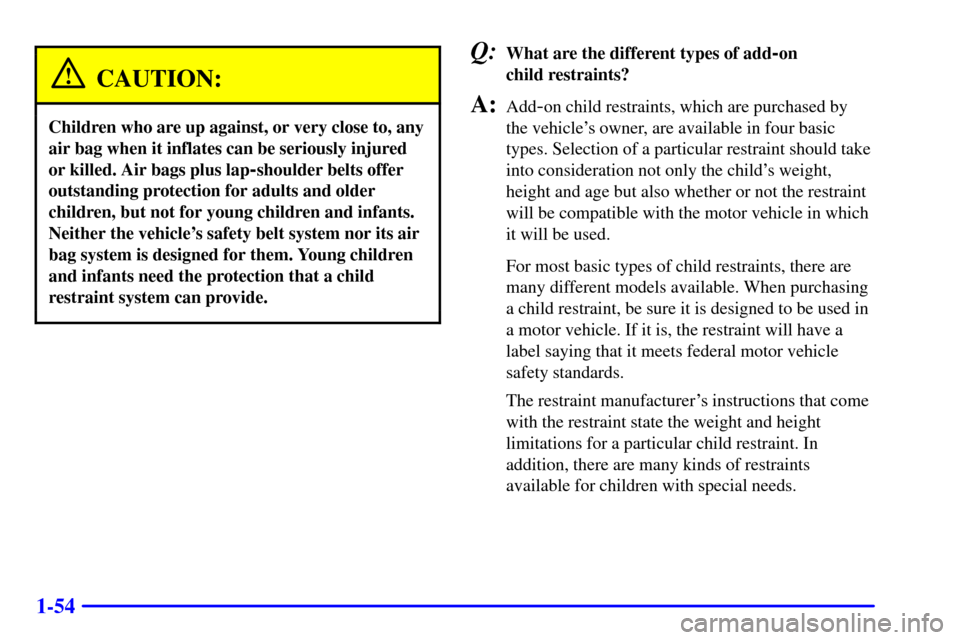
1-54
CAUTION:
Children who are up against, or very close to, any
air bag when it inflates can be seriously injured
or killed. Air bags plus lap
-shoulder belts offer
outstanding protection for adults and older
children, but not for young children and infants.
Neither the vehicle's safety belt system nor its air
bag system is designed for them. Young children
and infants need the protection that a child
restraint system can provide.
Q:What are the different types of add-on
child restraints?
A:Add-on child restraints, which are purchased by
the vehicle's owner, are available in four basic
types. Selection of a particular restraint should take
into consideration not only the child's weight,
height and age but also whether or not the restraint
will be compatible with the motor vehicle in which
it will be used.
For most basic types of child restraints, there are
many different models available. When purchasing
a child restraint, be sure it is designed to be used in
a motor vehicle. If it is, the restraint will have a
label saying that it meets federal motor vehicle
safety standards.
The restraint manufacturer's instructions that come
with the restraint state the weight and height
limitations for a particular child restraint. In
addition, there are many kinds of restraints
available for children with special needs.